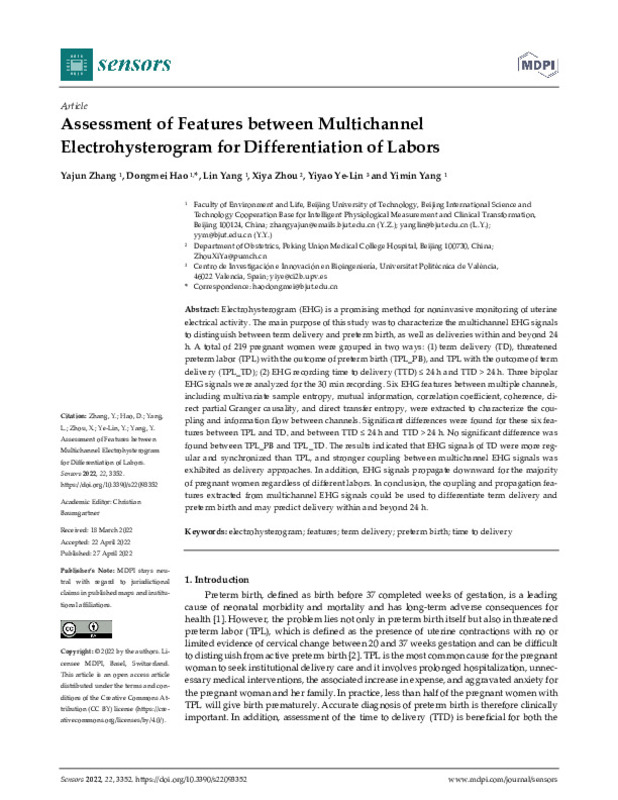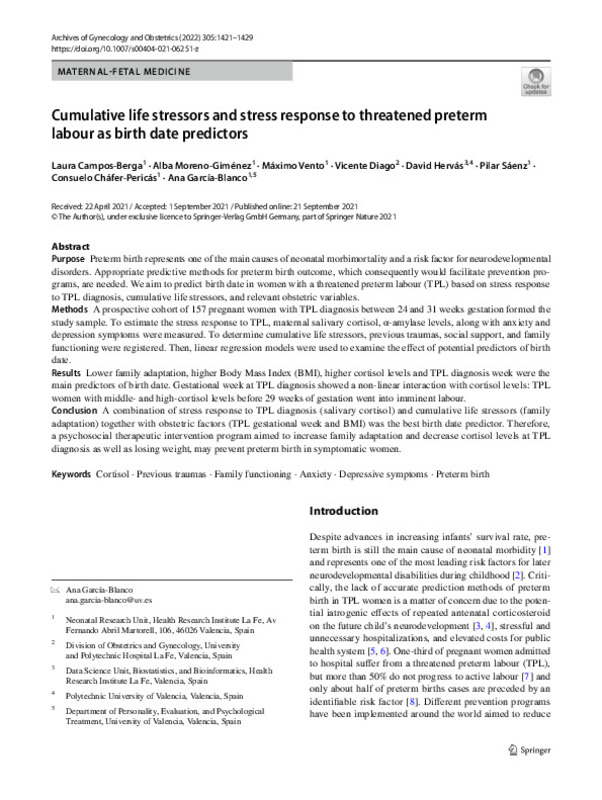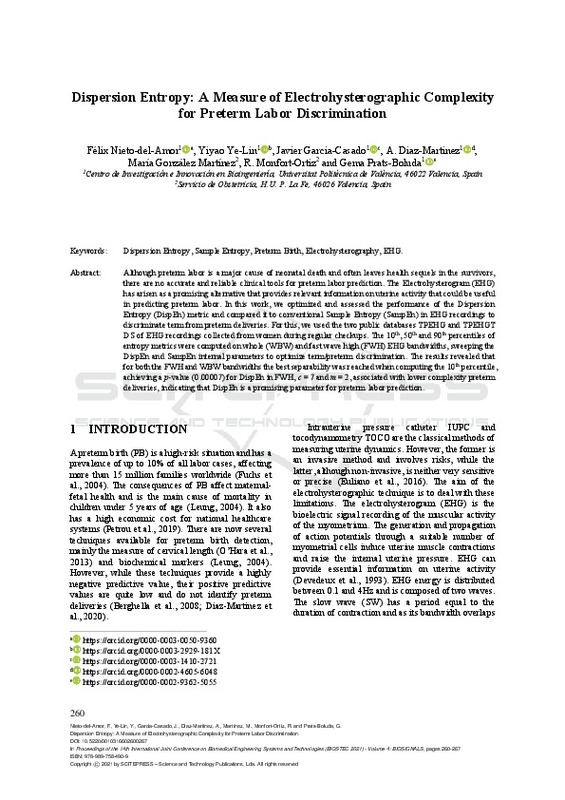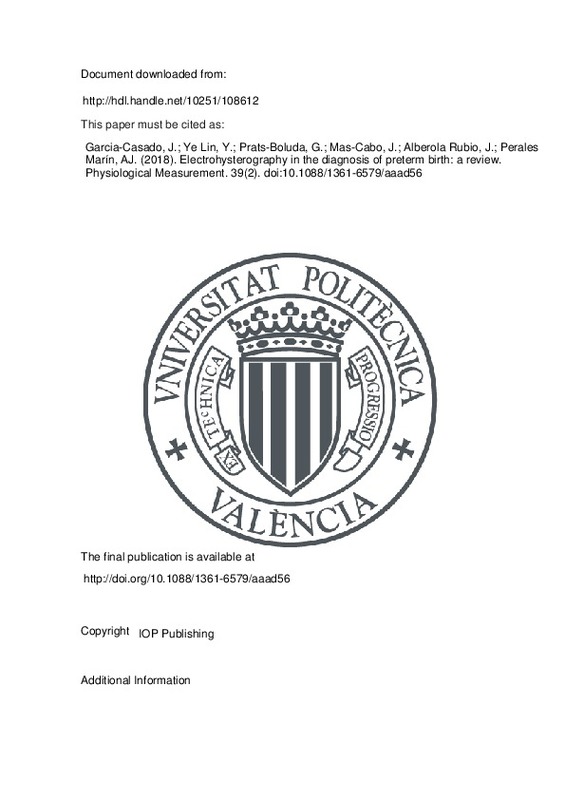

Listar por palabra clave "Preterm birth"
RiuNet: Repositorio Institucional de la Universidad Politécnica de Valencia
- RiuNet repositorio UPV
- :
- Listar por palabra clave
JavaScript is disabled for your browser. Some features of this site may not work without it.
Buscar en RiuNet
Listar
Mi cuenta
Ayuda RiuNet
Admin. UPV
Listar por palabra clave "Preterm birth"
Mostrando ítems 1-8 de 8
-
Zhang, Yajun; Hao, Dongmei; Yang, Lin; Zhou, Xiya; Ye Lin, Yiyao; Yang, Yimin (MDPI AG, 2022-05)[EN] Electrohysterogram (EHG) is a promising method for noninvasive monitoring of uterine electrical activity. The main purpose of this study was to characterize the multichannel EHG signals to distinguish between term ...
-
Díaz Martínez, María del Alba (Universitat Politècnica de València, 2024-07-11)[ES] Durante la gestación, la mujer experimenta cambios fisiológicos, metabólicos y morfológicos que podrían conllevar importantes riesgos materno-fetales. En primer lugar, el parto prematuro es la principal causa de ...
-
Campos-Berga, Laura; Moreno-Giménez, Alba; Vento, Máximo; Diago, Vicente; Hervás-Marín, David; Sáenz, Pilar; Cháfer-Pericás, Consuelo; García-Blanco, Ana (Springer-Verlag, 2022-06)[EN] Purpose Preterm birth represents one of the main causes of neonatal morbimortality and a risk factor for neurodevelopmental disorders. Appropriate predictive methods for preterm birth outcome, which consequently would ...
-
Pastor Tronch, Julio (Universitat Politècnica de València, 2020-12-04)[ES] La amenaza de parto prematuro (APP) es una de las principales causas de hospitalización en todo el mundo durante la segunda etapa del embarazo e implica una serie de tratamientos de elevado coste y cierto riesgo tanto ...
-
Dispersion Entropy: A Measure of Electrohysterographic Complexity for Preterm Labor Discrimination Nieto-del-Amor, Félix; Ye Lin, Yiyao; Garcia-Casado, Javier; Díaz-Martínez, María del Alba; González Martínez, María; Monfort-Ortiz, R.; Prats-Boluda, Gema (SCITEPRESS, 2021-02-13)[EN] Although preterm labor is a major cause of neonatal death and often leaves health sequels in the survivors, there are no accurate and reliable clinical tools for preterm labor prediction. The Electrohysterogram (EHG) ...
-
Garcia-Casado, Javier; Ye Lin, Yiyao; Prats-Boluda, Gema; Mas-Cabo, Javier; Alberola Rubio, José; Perales Marin, Alfredo Jose (IOP Publishing, 2018)[EN] Preterm birth (PTB) is one of the most common and serious complications in pregnancy. About 15 million preterm neonates are born every year, with ratios of 10-15% of total births. In industrialized countries, preterm ...
-
Diaz-Martinez, Alba; Prats-Boluda, Gema; Monfort-Ortiz, Rogelio; Garcia-Casado, Javier; Roca-Prats, Alba; Tormo-Crespo, Enrique; Nieto del-Amor, Félix; Diago-Almela, Vicente-José; Ye-Lin, Yiyao (Elsevier Masson, 2024-06)[EN] Background for the research: Premature birth and its associated complications are one of the biggest global health problems, since there is currently no effective screening method in clinical practice to accurately ...
-
Buesa, Julia; Lizaran, Marta; Almansa, Belén; Ghosn, Farah; Campos-Berga, Laura; Hervás-Marín, David; Andreu, Julia; Sierra, Pilar; Livianos, Lorenzo; Vento, Máximo; Diago, Vicente; García-Blanco, Ana (Elsevier BV, 2024-03)[EN] BACKGROUND: Recent research suggests that children born after suspected preterm labor may observe a potential cluster with different attention deficit hyperactivity disorder features, depending on the time of birth. ...
Mostrando ítems 1-8 de 8

Universitat Politècnica de València. Unidad de Documentación Científica de la Biblioteca (+34) 96 387 70 85 · RiuNet@bib.upv.es









